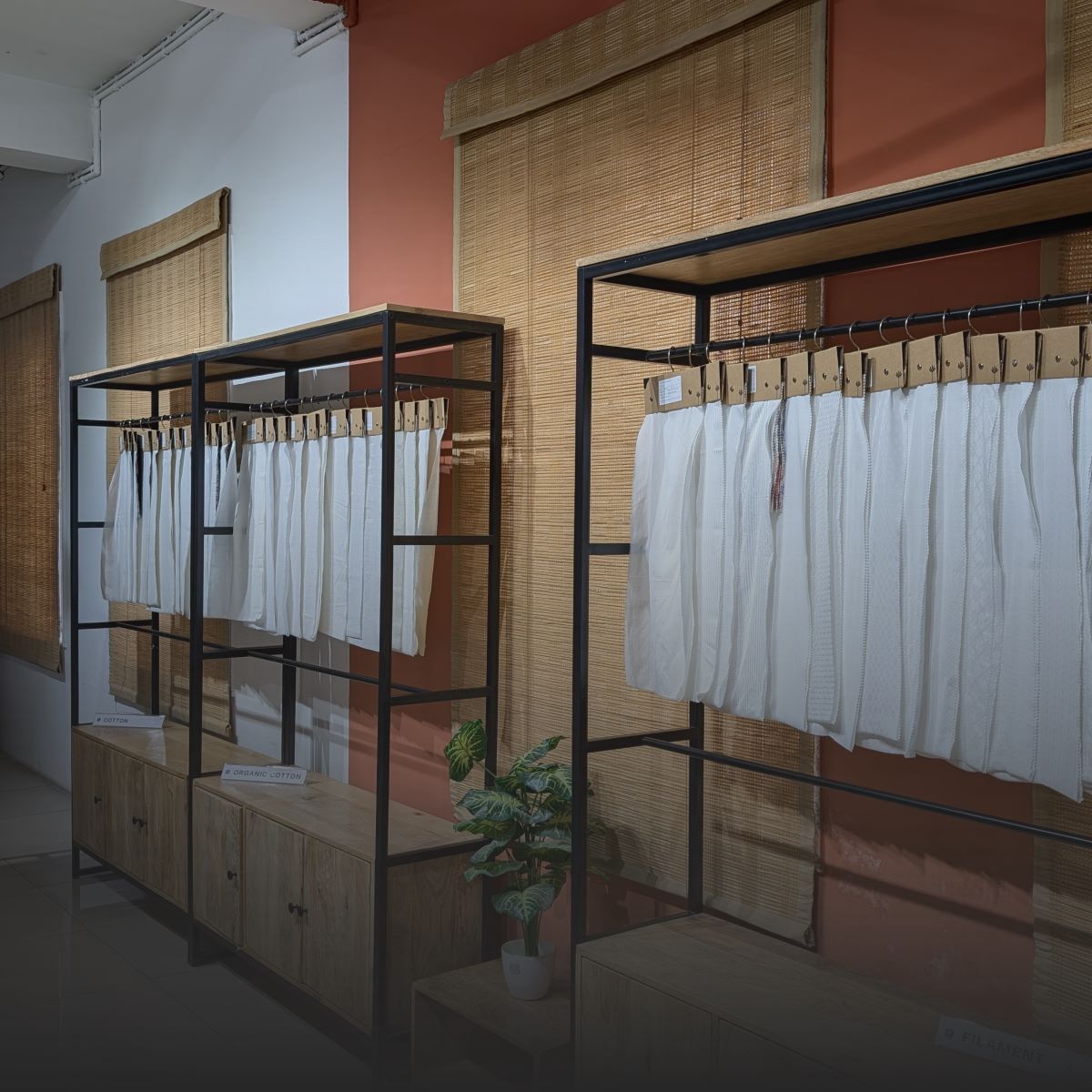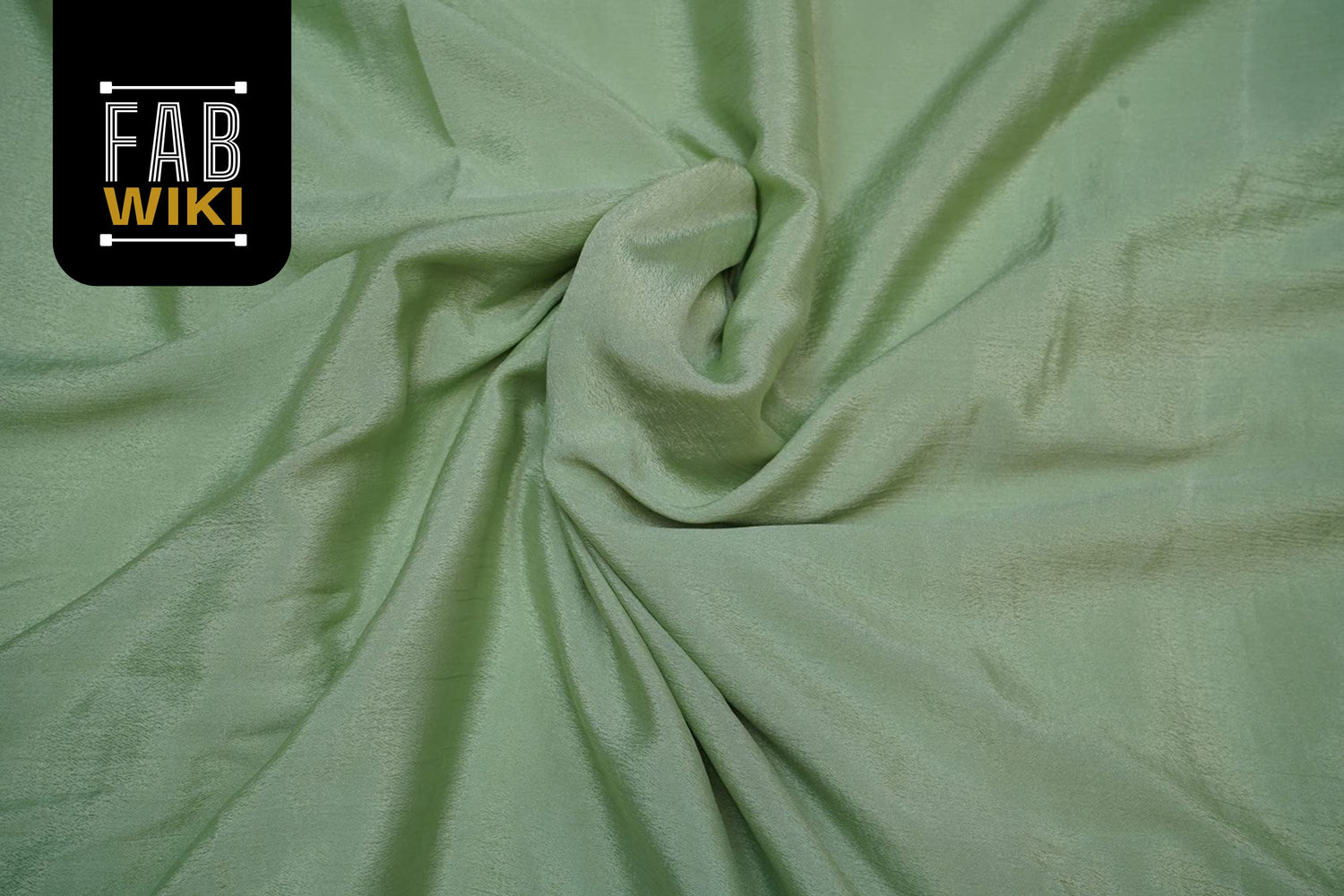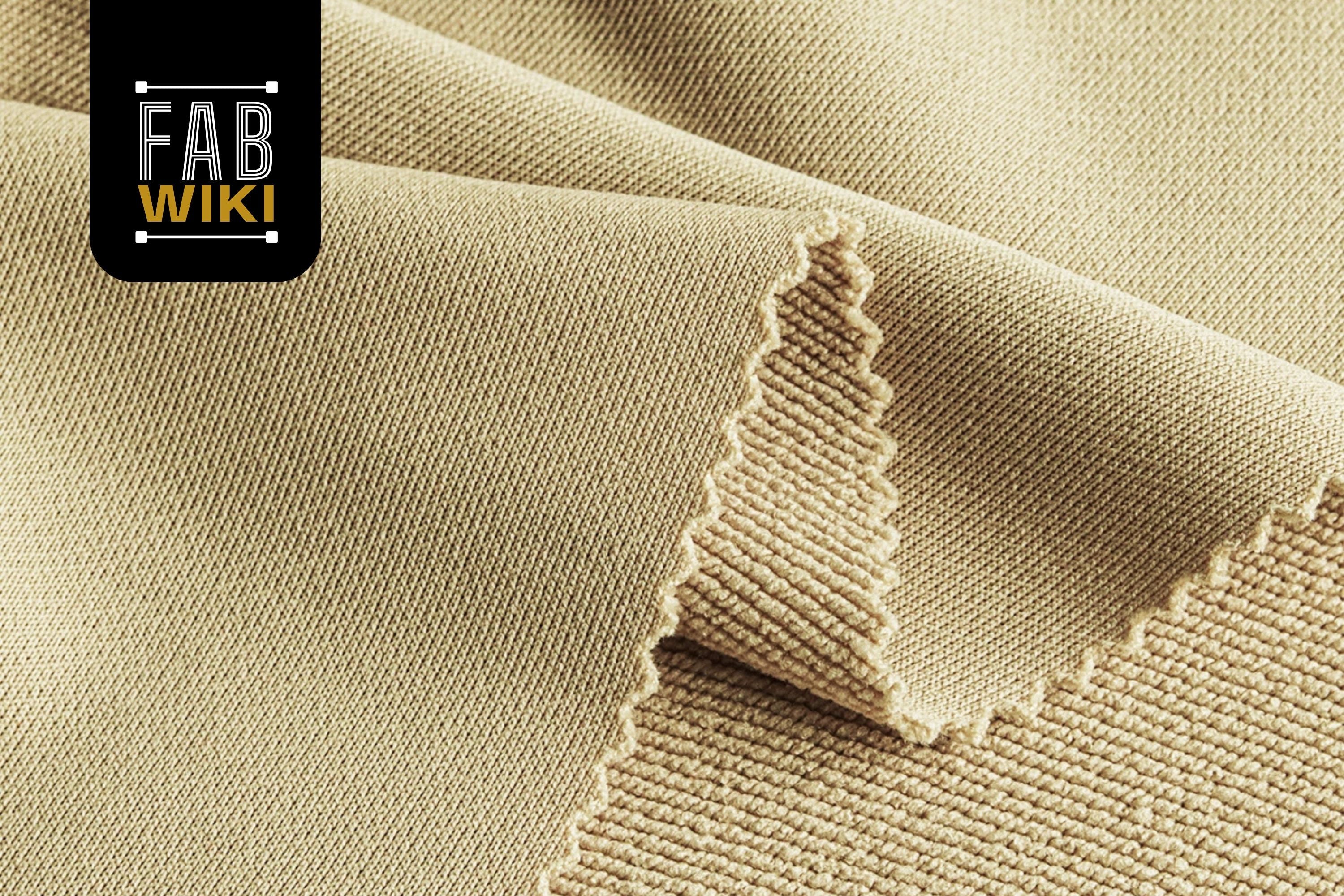Chinon fabric is a refined way to get the drape, flow, and grace that you're looking for. It's often used in sarees, gowns, scarves, and dresswear because it's light, has a semi-sheer finish, and has a subtle sheen. To produce high-quality collections ready for the market, brands and textile buyers need to understand Chinon well, including its fibre composition, construction, processing, performance specifications, and sourcing parameters.
What Is Chinon Fabric?

Chinon, also written as "Chinnon" or "Chinon chiffon," is a light, semi-sheer fabric with a smooth, slightly shiny surface. One source says that chinchang fabric is a semi-synthetic fabric made from both natural fibres, such as silk, and artificial fibres, such as polyester or rayon.
As another note says, "Chinon fabric is a light, sheer, and flowing material that is often used in the fashion industry to make sarees, dresses, and evening gowns."
The exact meaning of the word isn't clear; some sources say it comes from the name of a town in France called Chinon, but the term is now used for a broader range of fabrics, including synthetics and mixes.
Basic characteristics
- A drape that is light and flows.
- Most of the time, a mixed or filament yarn structure mixes silk fabric, polyester, rayon, or nylon.
- It has a sheer-to-semi-opaque look and is used for elegant, moving clothes.
- Dress fabrics, evening wear, dupattas, drapes, overlays, and high fashion all use this a lot.
Key Characteristics of Chinon Fabric

Knowing how something works and how it looks helps creators make wise choices. Here is a review, then the main points.
Chinon fabric is unique because it drapes well, has a soft hand, a slight sheen, and can be used for both formal and dress silhouettes. But aside from how it looks, it offers some valuable benefits, such as the ability to be printed on, layered, and, depending on its composition, moderate durability.
Core properties:
- Lightweight hand: Typically in a low to mid GSM range, making it ideal for flowy garments.
- Smooth surface & subtle sheen: Filament yarns or synthetic blends deliver refined luster.
- Good drape/fluidity: Suitable for gowns, overlays, scarves.
- Semi-sheer appearance: Often used in layered garments or with lining.
- Versatile fibre content: Found in pure silk, silk-blends, or full synthetic (polyester/nylon) versions.
- Good print/dye affinity: Works for digital prints or surface finishes.
- Care considerations: Depending on fibre, may need delicate handling (especially pure silk versions).
- Affordability tier variation: Synthetic or blend versions cost less than pure silk but maintain similar drape and aesthetic.
Benefits for Apparel Brands & Textile Buyers
Chinon fabric has a lot of great benefits for brands, buying managers, and textile buyers, such as:
Brand & sourcing advantages
- Premium appearance: The soft sheen and drape give garments a luxury feel, ideal for high-end or festive collections.
- Drapey versatility: Perfect for dresses, overlays, dupattas, bridesmaid wear, scarves, resortwear.
- Customisation potential: Blend possibilities (silk/synthetic), print-readiness, colour runs.
- Production-friendly: Many modern Chinon versions (polyester blends) offer better wrinkle resistance and easier care.
- Trend-adaptable: Works well with digital printing, bold motifs, and colour stories.
Direct benefits:
- Achieve a high-end look at a moderate cost by selecting blend versions.
- Enable layered or flowing silhouettes thanks to lightweight hands.
- Easy print/dye surface supports digital or reactive techniques.
- Helps brands build seasonal collections (e.g., partywear, ethnic, resort) with an elegant base fabric.
- Compatible with small-batch and large‐scale production thanks to the availability of synthetic variants.
Comparison Table – Chinon vs Closely Related Fabrics
To help differentiate and decide when Chinon is suitable versus other similar fabrics.
Types / Constructions Available
Chinon is available in multiple versions, depending on fibre, weight, construction, and finish. Below is a breakdown.
|
Type |
Composition |
Texture & Appearance |
Common Uses |
|
Pure silk chinon |
100% silk filament yarn |
Softest hand, natural sheen and luxury finish |
Bridal, couture gowns, luxury scarves |
|
Silk-synthetic blend chinon |
Silk + polyester/nylon/rayon |
Balanced luxury & cost-performance |
Premium sarees, festive wear |
|
Full synthetic chinon |
Polyester or nylon filament |
Similar drape and sheen, more cost-efficient |
Ready-to-wear dresses, prints |
|
Printed chinon |
Any base with digital or rotary print finish |
Lightweight, vibrant colours and motifs |
Printed dresses, ethnic wear, dupattas |
GSM / Weight Guidance & Technical Specification
When sourcing Chinon fabric, understanding weight (GSM/GLM), yarn count, weave, and finish is crucial for performance and production.
The weight of Chinon affects how it falls, how many meters are needed, how it layers, and how it wears on a garment. Specifying correct GSM and other technical specs helps align production cost and end-use quality.
GSM guidance
|
GSM Range |
Indicative Description |
Ideal Applications |
|
50–90 GSM |
Ultralight version, highly sheer |
Scarves, overlays, light maxi dresses |
|
90–140 GSM |
Typical dresswear weight for flowy garments |
Evening dresses, sarees, printed gowns |
|
140–200 GSM |
Heavier version with more body |
Structured overlays, layering skirts |
Additional specs to define:
- Yarn count (Ne or Tex) and filament nature.
- Width of fabric (common 44″/110 cm or 60″/150 cm).
- Finish type: sand-wash, softening, bio-wash.
- Sheerness/opacity – depending on lining needs.
- Colourfastness, shrinkage tolerance, and print finish durability.
How Chinon Fabric Is Made – Technical Process

Understanding how Chinon is manufactured helps sourcing teams assess quality and make informed decisions.
Chinon is typically produced by weaving or knitting filament yarns (silk or synthetic) into a lightweight fabric structure, often followed by finishing treatments (softening, luster enhancement, coating) to achieve that smooth, drapey feel and subtle shine.
Production steps:
- Selection of filament yarns (silk, polyester, nylon, etc.).
- Weaving/knitting into a lightweight structure, often plain weave or satin weave for sheen.
- Finishing: steaming, softening, sand-washing or chemical treatments to improve the hand.
- Optional print or dyeing: digital or rotary printing applied to the base fabric.
- Quality control: verifying weight, width, drape, colour uniformity, and shrinkage.
- Roll packing and dispatch for garment manufacturing.
Quality assurance is essential: checking filament integrity, colour consistency, hand feel and drape performance.
Applications by Category
Chinon fabric is very versatile due to its flow, sheerness, and finish. Here's a breakdown of ready‐to‐source applications.
|
Category |
Recommended Chinon Variant |
Key Benefits |
|
Evening / Occasion Dresses |
Silk or blend chinon 90–140 GSM |
Lustrous, drapes beautifully, premium feel |
|
Sarees & Dupattas |
Lightweight chinon 90–120 GSM |
Flowy fall, prints well, festive aesthetics |
|
Printed Dresses & Tops |
Synthetic chinon with print finish |
Colour rich, cost-effective, ready to wear |
|
Resortwear / Flowy Skirts |
Chinon blends 120–160 GSM |
Lightweight, comfortable, good hand feel |
|
Accessories (Scarves, Veils) |
Ultralight chinon 50–90 GSM |
Sheer, airy, layering piece |
Sourcing & Specification Checklist
When sourcing Chinon fabric for bulk production, brands and textile buyers must follow structured workflows and check key specification points.
To prevent quality issues or production mismatches, sourcing Chinon requires verifying fibre composition, weight, width, finish, print compatibility, and MOQ/lead time. Ensuring correct swatch testing, lab reports, and production readiness aligns with brand standards.
Checklist:
- Fibre content: specify 100% silk, blend, or synthetic.
- Weight/GSM & width of fabric.
- Finish: mention softening, sand-wash or high luster.
- Sheerness/opacity: depending on garment construction.
- Print/dye eligibility: reactive, digital, rotary compatibility.
- Drape test: to ensure fluid movement.
- Minimum order quantity (MOQ), roll length, and lead time.
- Quality tests: shrinkage, colourfastness, pilling (if applicable).
- Packaging and dispatch metrics for garment manufacturing.
Care & Maintenance
Because Chinon often uses filament yarns and a delicate structure, correct care ensures longevity and appearance.
Chinon fabrics — especially silk or silk blends — require gentle handling. Proper care includes delicate washing or dry cleaning, low-heat ironing, and avoiding heavy abrasion to maintain shine, drape and surface integrity.
Care tips:
- For silk/silk-blend chinon: dry-clean or handwash in cold water with a mild detergent.
- For synthetic chinon: gentle machine wash cold, hang or line dry.
- Iron at low heat on reverse or use a press cloth; avoid high heat, which could damage the filament.
- Avoid snagging: keep away from sharp edges or rough surfaces.
- Store folded in breathable covers, avoid direct sunlight for long periods to prevent fade or loss of lustre.
- Test the colourfastness before the full wash run if the print was made with Chinon.
Pros & Cons (Trade-Offs)
When selecting chinon fabric, it's important to balance its advantages with realistic production or care trade-offs.
Advantages:
- Elegant drape and flow-feel are suitable for high-end garments.
- A soft sheen and a lightweight hand elevate garment aesthetics.
- Greater cost flexibility with synthetic/silk blend versions.
- Versatile across categories: dresses, sarees, overlays, scarves.
Potential drawbacks:
- Pure silk chinon is expensive and may require special care.
- Sheer or semi-sheer nature may require lining or layering, increasing cost.
- A lightweight structure may be prone to snags or damage if handled roughly.
- Synthetic chinon may sacrifice some natural fibre premium feel for cost.
- Print finishes may need extra testing for bleed, rub-off, and colour fastness on filaments.
Trends & Innovations
The market for flowy, elegant fabrics like chinon is evolving alongside technological advances, sustainability initiatives, and fashion shifts.
Key trend areas:
- Digital printing on Chinon: vibrant, high-definition prints on lightweight bases.
- Blended chions with breathable synthetics: to combine drape + durability + cost efficiency.
- Eco variants: Synthetic filament versions with recycled polyester or other low-impact fibres.
- Hybrid layering fabrics: Chinon is used as an overlay in dresses or mixed with solid fabrics for contrast.
- Cross-cultural usage: In South Asia, chinon is widely used in sarees, partywear, and bridalwear.
Final Thoughts
Chinon fabric is a wise choice for designers, brands and textile procurement teams seeking lightweight elegance, flow, and versatility. Whether for evening gowns, festive sarees, printed dresses or resortwear, knowing its fibre options, weight specs, finish treatments and sourcing parameters ensures success.
You can get the most out of Chinon fabric by making sure that your garment brief, technical specs (GSM, width, drape), supplier sampling, and quality control are all in sync. This will help you make clothes that look great, move easily, and meet brand standards.
FAQs
Q1. What Is Chinon Fabric Made Of?
Chinon fabric is typically made from filament yarns, such as silk, or blended fibres (silk + polyester/nylon or full synthetic polyester). It combines lightweight drapes, soft, shiny surfaces, and often semi-sheer structures.
Q2. Is Chinon Fabric Suitable For Summer Dresses Or Sarees?
Yes — especially variants in lightweight GSM (90-140 g/m²) are ideal for summer wear because they are breathable, flowy and elegant, making them perfect for sarees, dresses, maxi gowns and overlays.
Q3. What Should I Specify When Sourcing Chinon Fabric In Bulk?
You should specify: fibre content (silk, blend, synthetic), GSM/weight, width, finish type (softening or wash), print/dye compatibility, drape hand feel, roll length, MOQ and test reports for colourfastness and shrinkage.
Q4. Can Chinon Fabric Be Printed Or Dyed Easily For Fashion Collections?
Yes — many chinon bases support reactive dyeing (in natural fibre or blends) or digital/rotary printing (especially synthetic filament versions), which enables high-definition prints and seasonal colour runs.
Q5. How Should I Care For Garments Made Of Chinon Fabric?
Handle with care — for silk/chinon blends, dry cleaning is safest; synthetic versions can be handwashed cold or machine-washed on a gentle cycle. Iron at low heat on the reverse side; avoid rough surfaces that could snag the lightweight construction.
We also happen to be a magnet for suggestions, and would love to catch yours….throw us yours on hello@fabriclore.com




